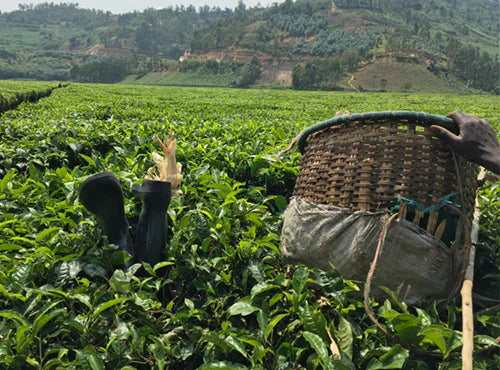tea and our tea taster
our tea taster
Louise is our tea taster. A genuine got the t-shirt, badge and apron trained master of tea.
Fully-trained tea tasters are few and far between, so we are super-proud to be able to say that teapigs teas have been tasted and selected by an expert with over 10 years' experience. Louise has tasted thousands and thousands of cups of teas over the years. After starting her training, which involved slurping and spitting at a rate of over 200 cups a day, she then took off around the world visiting tea estates high and low.
what is tea?
Whether black, green, white or oolong, all tea comes from the leaves of the camellia sinensis plant.
But that's just the start. Like wine, tea is divided into regional varieties and manufacturing styles. For example you will only find the very best Darjeeling black tea growing in the foothills of the Himalayas. Alternatively, the traditional fermentation and drying methods uniquely used in Taiwan produces the special flavour of Tung Ting oolong.

where does tea come from?
Tea usually grows between the tropic of Cancer and the tropic of Capricorn, predominantly in warm, wet climates. The big players in the world of tea-growing are India, China, Sri Lanka and Kenya but this is by no means an exhaustive list: tea can be grown in any area with the right climate and conditions. There is even a tea-growing area in Cornwall - yes, Cornwall, England!
good tea vs bad tea?
A good tea is a well-made tea - one that has been looked after and finely crafted. Generally tea estates have to choose between making large volumes of ok tea or a smaller amount of something really top-quality. If they choose the latter they will only pick the best leaves (the freshest shoots from the top of the bush) and process them very delicately ensuring that they don't damage the leaf.
We always say, The best tea is the one you love the best. And if you're anything like us, that will change depending on the time, the occasion, even your mood. We love all our teas, at different times - asking us to pick one would be like a parent choosing a favourite child! What you can be sure of is that teapigs teas will always be of the finest quality.
more about tea
We think it is amazing that one plant can produce so many unique flavours and tastes. The taste variation starts in the growing of the plant - the location, the soil, the altitude, the weather pattern. The way the leaves are treated after plucking changes the final flavour of the tea, we have tried to sum this up in non-tea-geek speak below.

green tea
The leaf is plucked from the bush and then either roasted (in something resembling a giant wok) or steamed like your veggies (in a big cylinder.) The leaf is then dried, sealing in the greenness. Steamed green teas tend to have a more delicate taste than the roasted version.

black tea
Black tea is plucked from the bush and withered in the open air. When the leaf becomes soft it is twisted and then fermented. The fermentation is the most important and skilled stage; this is when the leaf oxidizes. Finally the leaf is cooked in a giant oven to seal in the flavour.
more about herbals
The rule is a simple one: if it's tea, it must come from the camellia sinensis plant. So what of peppermint tea or chamomile tea? Well, strictly speaking, they're not tea at all, but infusions or, for the truly pretentious, tisanes.
Our view is they make a great cuppa in their own right, and so are worthy of the tea title. They also have their own unique health boosting properties.

chamomile
Chamomile is one of the old favourites amongst garden herbs and its reputation as a medicinal plant that makes you snooze is well known. The fresh plant has a lovely scent, with a distinct 'appley' smell – not lost on the Greeks, who named it 'ground-apple' ( Kamal-melon).
There are many reputed benefits of drinking chamomile. It is believed to strengthen the immune system, aid digestion, calm nerves and ease stomach pains.

peppermint
We all know a mug of peppermint tea helps digestion. Alternative therapies include gargling peppermint tea 3 times a day helps a sore throat. If you have dry or itchy skin, it is thought that adding peppermint tea to your bath will help.

lemongrass
Lemongrass is a perennial tufted grass with long, sharp-edged blades, and grows in dense clumps in tropical or subtropical climates. The plants last three to four years and are harvested every three to five months. Lemongrass is grown throughout Southeast Asia, Southern India, Sri Lanka, Central Africa, Brazil, Guatemala, the US and the West Indies.It has been used for centuries in Indonesia and Malaysia by herbalists and in Ayurvedic herbalism. It is used to combat depression and bad moods, fight fever (as it induces perspiration), and aid nervous and digestive disorders. And it's well known as an insect repellent. If that's not enough, more recent studies have shown that it even has antibacterial and antifungal properties. (buy our lemongrass)

liquorice
Liquorice, or sweet root as it is known, is grown throught Europe and Asia. The roots of the small liquorice plant extend to 30ft in length. It is this root which is used to make our tea. Whilst a plateful of pontefract cakes or liquorice allsorts won't cure the common cold, our liquorice and mint brew may well help. Pure liquorice root is thought to ease coughs and respiratory problems. (buy our liquorice tea)

ginger
A perenial plant, it is, again, the root which holds the flavour.The spicy, strong flavour of ginger is thought to help with heart conditions, arthritis and nausea. In the teapigs office, lemon and ginger is a favourite cure for man flu (according to Nick and Reggie).







